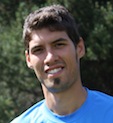1st session, September 24th & 25th 2013
Video report here
Tuesday 24
9h30 - 10h : Coffee
10h - 11h : Hiroshi Matano (University of Tokyo)

Spreading speed for some two-component reaction-diffusion system
In this talk I will discuss the spreading properties of solutions of a prey-predator type reaction-diffusion system. This system belongs to the class of reaction-diffusion systems for which the comparison principle does not hold. For such class of systems, little has been know about the spreading properties of the solutions. Here, by a spreading property, we mean the way the solution propagates when starting from compactly supported initial data. We show that propagation of both the prey and the predator occur with a definite spreading speed. Furthermore, quite intriguingly, the spreading speed of the prey and that of the predator are different in some situations. This is joint work with Arnaud Ducrot and Thomas Giletti.
In this talk I will discuss the spreading properties of solutions of a prey-predator type reaction-diffusion system. This system belongs to the class of reaction-diffusion systems for which the comparison principle does not hold. For such class of systems, little has been know about the spreading properties of the solutions. Here, by a spreading property, we mean the way the solution propagates when starting from compactly supported initial data. We show that propagation of both the prey and the predator occur with a definite spreading speed. Furthermore, quite intriguingly, the spreading speed of the prey and that of the predator are different in some situations. This is joint work with Arnaud Ducrot and Thomas Giletti.
11h - 12h : Xavier Cabré (ICREA and UPC, Barcelona)

Sharp isoperimetric inequalities via the ABP method
We prove some old and new isoperimetric inequalities with the best constant via the ABP method. More precisely, we obtain a new family of sharp isoperimetric inequalities with weights (or densities) in open convex cones of $mathbb{R}^n$. Our results apply to all nonnegative homogeneous weights satisfying a concavity condition in the cone. Surprisingly, even that our weights are not radially symmetric, Euclidean balls centered at the origin (intersected with the cone) minimize the weighted isoperimetric quotient. As a particular case of our results, we provide with new proofs of classical results such as the Wulff inequality and the isoperimetric inequality in convex cones of Lions and Pacella. Furthermore, we also study the anisotropic isoperimetric problem for the same class of weights and we prove that the Wulff shape always minimizes the anisotropic weighted perimeter under the weighted volume constrain.
We prove some old and new isoperimetric inequalities with the best constant via the ABP method. More precisely, we obtain a new family of sharp isoperimetric inequalities with weights (or densities) in open convex cones of $mathbb{R}^n$. Our results apply to all nonnegative homogeneous weights satisfying a concavity condition in the cone. Surprisingly, even that our weights are not radially symmetric, Euclidean balls centered at the origin (intersected with the cone) minimize the weighted isoperimetric quotient. As a particular case of our results, we provide with new proofs of classical results such as the Wulff inequality and the isoperimetric inequality in convex cones of Lions and Pacella. Furthermore, we also study the anisotropic isoperimetric problem for the same class of weights and we prove that the Wulff shape always minimizes the anisotropic weighted perimeter under the weighted volume constrain.
14h - 14h45 : Juliette Bouhours

Front propagation and blocking phenomena in cylinder with varying cross section
We consider a bistable reaction diffusion equation in an infinite cylinder with varying cross section and we investigate the existence of propagation phenomena (possibly partial propagation) or on the contrary of blocking phenomena. We prove that in the case of a decrease in the diameter of the cross sections there is complete propagation whereas if the diameter increases, the solution can be blocked when it faces the change in the geometry. We also prove that in the case of an increase of the diameter of the cross section, if the diameter before the change in the geometry is large enough, then the solution propagates. Lastly we consider the case of a progressive change in the geometry and prove that if the domain is close to a straight cylinder then the solution propagates in the entire domain. This is a work in collaboration with Henri Berestycki and Guillemette Chapuisat.
We consider a bistable reaction diffusion equation in an infinite cylinder with varying cross section and we investigate the existence of propagation phenomena (possibly partial propagation) or on the contrary of blocking phenomena. We prove that in the case of a decrease in the diameter of the cross sections there is complete propagation whereas if the diameter increases, the solution can be blocked when it faces the change in the geometry. We also prove that in the case of an increase of the diameter of the cross section, if the diameter before the change in the geometry is large enough, then the solution propagates. Lastly we consider the case of a progressive change in the geometry and prove that if the domain is close to a straight cylinder then the solution propagates in the entire domain. This is a work in collaboration with Henri Berestycki and Guillemette Chapuisat.
14h45 - 15h30 : Laurent Dietrich

Front propagation directed by a line of fast diffusion : existence of travelling waves.
In a recent paper, Berestycki, Roquejoffre and Rossi study the influence of a line with fast diffusion on front propagation. In the context of Fisher KPP propagation, they show that spreading can be enhanced. The issue is to understand whether such a property persists outside the Fisher-KPP context. For a reaction term with a threshold, we show the existence of travelling waves, and investigate the fast diffusion limit.
In a recent paper, Berestycki, Roquejoffre and Rossi study the influence of a line with fast diffusion on front propagation. In the context of Fisher KPP propagation, they show that spreading can be enhanced. The issue is to understand whether such a property persists outside the Fisher-KPP context. For a reaction term with a threshold, we show the existence of travelling waves, and investigate the fast diffusion limit.
15h30 - 16h : Coffee break
16h - 16h45 : Jimmy Garnier

Genetic consequences of range expansion : mathematical insights
In this talk, I will present some reaction-dispersion equations with local and nonlocal dispersion terms and either monostable or bistable reaction terms. The goal of the talk is to present a new approach to study the inside dynamics of solutions which propagate in space. I will first focus on the reaction-diffusion traveling wave to present the notion of pulled and pushed traveling waves. Then, I will investigate the integro-diffrential traveling waves and the accelerating solutions of integro-differential equations. We will see that this approach gives some insights on the consequences of range expansion of population on their diversity.
In this talk, I will present some reaction-dispersion equations with local and nonlocal dispersion terms and either monostable or bistable reaction terms. The goal of the talk is to present a new approach to study the inside dynamics of solutions which propagate in space. I will first focus on the reaction-diffusion traveling wave to present the notion of pulled and pushed traveling waves. Then, I will investigate the integro-diffrential traveling waves and the accelerating solutions of integro-differential equations. We will see that this approach gives some insights on the consequences of range expansion of population on their diversity.
Wednesday 25
9h30-10h: Coffee
10h - 11h: Jean-Pierre Nadal (CAMS and LPS)

Modeling urban social dynamics
I will present models recently introduced for the modeling of social dynamics in urban context: social segregation, diffusion of criminality. In both cases, individual decisions (such as, respectively, to buy an appartment at a particular location, to commit a crime), may strongly depend on the behaviour/decisions of others. Based on social theories and empirical data, we consider family of models in which agents behaviour is coupled to a spatio-temporal field (representing, e.g., the attractiveness of the appartments, the local expected payoff of a theft or local propensity to commit a crime), which depends itself on the agents behaviours/choices (the social composition of the neighborhood, the local criminality level). We instantiate these models as either agent-based systems or a set of partial diffusion equations. The goal is to explain collective patterns. I will present results for specific cases, a model of the housing market in Paris, and/or a model for the formation of criminal hotspots.
References :
Laetitia Gauvin, Annick Vignes and Jean-Pierre Nadal Modeling urban housing market dynamics: can the socio-spatial segregation preserve some social diversity? Journal of Economic Dynamics and Control (JEDC), Volume 37, Issue 7, July 2013, Pages 1300-1321.
Henri Berestycki and Jean-Pierre Nadal "Self-Organized Critical Hot Spots of Criminal Activity" European Journal of Applied Mathematics, Volume 21, Special Double Issue 4-5, Oct 2010, pp 371-399.
I will present models recently introduced for the modeling of social dynamics in urban context: social segregation, diffusion of criminality. In both cases, individual decisions (such as, respectively, to buy an appartment at a particular location, to commit a crime), may strongly depend on the behaviour/decisions of others. Based on social theories and empirical data, we consider family of models in which agents behaviour is coupled to a spatio-temporal field (representing, e.g., the attractiveness of the appartments, the local expected payoff of a theft or local propensity to commit a crime), which depends itself on the agents behaviours/choices (the social composition of the neighborhood, the local criminality level). We instantiate these models as either agent-based systems or a set of partial diffusion equations. The goal is to explain collective patterns. I will present results for specific cases, a model of the housing market in Paris, and/or a model for the formation of criminal hotspots.
References :
Laetitia Gauvin, Annick Vignes and Jean-Pierre Nadal Modeling urban housing market dynamics: can the socio-spatial segregation preserve some social diversity? Journal of Economic Dynamics and Control (JEDC), Volume 37, Issue 7, July 2013, Pages 1300-1321.
Henri Berestycki and Jean-Pierre Nadal "Self-Organized Critical Hot Spots of Criminal Activity" European Journal of Applied Mathematics, Volume 21, Special Double Issue 4-5, Oct 2010, pp 371-399.
11h - 12h : Xavier Cabré (ICREA and UPC, Barcelona)

Nonlinear elliptic and Fisher-KPP equations with fractional diffusion
I will first describe the basic ideas concerning fractional Laplacians, as well as the essential tools to treat nonlinear equations involving these operators. I will then present recent results on fractional semilinear elliptic equations (mainly of Allen-Cahn type) and on front propagation for fractional Fisher-KPP type equations.
I will first describe the basic ideas concerning fractional Laplacians, as well as the essential tools to treat nonlinear equations involving these operators. I will then present recent results on fractional semilinear elliptic equations (mainly of Allen-Cahn type) and on front propagation for fractional Fisher-KPP type equations.
14h - 14h45 : Anne-Charline Coulon (IMT, Toulouse)

Propagation in Fisher-KPP type equations with fractional Laplacian in periodic media
We are interested in the time asymptotic location of the level sets of solutions to Fisher-KPP reaction-diffusion equations with fractional diffusion in periodic media. We show that the speed of propagation is exponential in time, with a precise exponent depending on a periodic principal eigenvalue, and that it does not depend on the space direction. This is in contrast with the Freidlin-G"artner formula for the standard Laplacian. The method developped enables the treatment of a model of front propagation directed by a line where integral diffusion occurs.
We are interested in the time asymptotic location of the level sets of solutions to Fisher-KPP reaction-diffusion equations with fractional diffusion in periodic media. We show that the speed of propagation is exponential in time, with a precise exponent depending on a periodic principal eigenvalue, and that it does not depend on the space direction. This is in contrast with the Freidlin-G"artner formula for the standard Laplacian. The method developped enables the treatment of a model of front propagation directed by a line where integral diffusion occurs.
14h45 - 15h30 : Andrea Tellini(Universidad Complutense de Madrid)

How a line bounding a strip-shaped field affects Fisher-KPP propagation.
In this talk I will describe the effects on classical Fisher-KPP propagation due to a road that bounds on one side a strip-shaped field. On the other side of the strip we consider Dirichlet boundary conditions. In particular, I will show the analogies and differences of the asymptotic speed of propagation with respect to case in which the field is a half-plane, which has been studied in [1].
References:
[1] H. Berestycki, J.-M. Roquejoffre, L. Rossi, The influence of a line with fast diffusion in Fisher-KPP propagation, J. Math. Biology 66 (2013), 743-766.
In this talk I will describe the effects on classical Fisher-KPP propagation due to a road that bounds on one side a strip-shaped field. On the other side of the strip we consider Dirichlet boundary conditions. In particular, I will show the analogies and differences of the asymptotic speed of propagation with respect to case in which the field is a half-plane, which has been studied in [1].
References:
[1] H. Berestycki, J.-M. Roquejoffre, L. Rossi, The influence of a line with fast diffusion in Fisher-KPP propagation, J. Math. Biology 66 (2013), 743-766.
15h30-16h: Coffee break
16h-16h45: Jérôme Coville (MIA, INRA)

Convergence to the equilibrium in mutation selection models.
I will talk about mutation-selection models and expose some results concerning their equilibria and their global stability. More precisely, after a brief introduction to the context of this study, I will mainly focus on some continuous models of mutation selection for which we can prove that the equilibrium is unique and globally positively stable. I will end by some integrodifferential models exhibiting concentration phenomena.
I will talk about mutation-selection models and expose some results concerning their equilibria and their global stability. More precisely, after a brief introduction to the context of this study, I will mainly focus on some continuous models of mutation selection for which we can prove that the equilibrium is unique and globally positively stable. I will end by some integrodifferential models exhibiting concentration phenomena.
